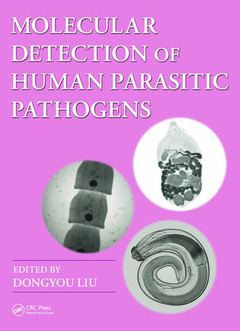Molecular Detection of Human Parasitic Pathogens
Coordonnateur : Liu Dongyou

Traditionally, laboratory identification of parasites has relied upon various phenotypic procedures that detect their morphological, biological, and immunological features. Because these procedures tend to be time-consuming and technically demanding, molecular methods based on nucleic acid amplification technologies have been increasingly utilized for rapid, sensitive, and specific characterization of parasites.
The large number of original and modified molecular protocols that have been developed over the years creates a dilemma for those attempting to adopt the most appropriate protocol for streamlined identification and detection of human pathogenic organisms of interest. Part of a four-volume collection, Molecular Detection of Human Parasitic Pathogens provides a reliable and comprehensive resource on the molecular detection and identification of major human parasitic pathogens.
This volume contains expert contributions from international scientists involved in human parasitic pathogen research and diagnosis. Following a similar format throughout, each chapter includes:
- A brief review on the classification, biology, epidemiology, clinical features, and diagnosis of an important pathogenic parasitic genus/group
- An outline of clinical sample collection and preparation procedures and a selection of representative stepwise molecular protocols
- A discussion on further research needs relating to improved diagnoses of major human parasitic pathogens
This versatile reference on molecular detection and identification of major human parasitic pathogens is an indispensable tool for upcoming and experienced medical, veterinary, and industrial laboratory scientists engaged in parasite characterization. It is also suitable as a textbook for undergraduate and graduate students majoring in parasitology.
Sarcomastigophora: Acanthamoeba. Balamuthia. Blastocystis. Dientamoeba. Entamoeba. Giardia. Leishmania. Naegleria. Pentatrichomonas. Trichomonas. Trypanosoma. Ciliophora and Apicomplex: Babesia. Balantidium. Cryptosporidium. Cyclospora. Isospora. Plasmodium. Sarcocystis. Toxoplasma. Platyhelminthes: Cestoda: Diphyllobothrium. Dipylidium. Echinococcus and Echinococcosis. Hymenolepis. Mesocestoides. Spirometra. Taenia. Platyhelminthes: Trematoda: Clonorchis. Dicrocoelium. Echinostomes. Fasciola. Fasciolopsis. Gastrodiscoides. Haplorchis. Heterophyidae. Metagonimus. Nanophyetus. Opisthorchis. Paragonimus. Plagiorchis. and Schistosomiasis. Trichobilharzia. Nematoda: Ancylostoma. Angiostrongylus. Anisakis. Ascaris. Baylisascaris. Brugia. Capillaria. Dioctophyme. Dirofilaria. Dracunculus. Enterobius. Gnathostoma. Haemonchus. Loa. Mansonella. Marshallagia. Necator. Oesophagostomum. Onchocerca. Pseudoterranova and Contracaecum. Strongyloides. Syphacia. Thelazia. Toxocara. Trichinella. Trichostrongylus. Trichuris. Wuchereria. Arthropoda: Arachnida: Argasidae (Soft Ticks). Demodex (Hair Follicle Mite). Dermanyssus, Ornithonyssus, and Trombicula (red, fowl, and harvest mites). Ixodidae (Hard Ticks). Pyroglyphidae and Glycyphagidae (House Dust and Storage Mites). Sarcoptes (Itch Mite). Arthropoda: Insecta: Calliphoridae, Oestridae, and Sarcophagidae (Myiasis-Causing Flies). Cimex (Bedbug). Pediculus (Body and Head Lice). Phthirus (Crab Louse). Pulex, Xenopsylla, and Ctenocephalides (Human, Rat and Dog/Cat Fleas). Tunga (Jigger Flea). Arthropoda: Pentastomida: Armillifer, Linguatula, and Porocephalus (Tongue Worms).
Date de parution : 06-2012
Ouvrage de 832 p.
21x28 cm
Thèmes de Molecular Detection of Human Parasitic Pathogens :
Mots-clés :
SAMPLE PREPARATION; Adult Worms; internal; Intermediate Hosts; transcribed; Real Time PCR; spacer; Life Cycle; adult; ITS2 Region; worm; ATL Buffer; intermediate; Its Sequence; host; Parasite DNA; polymerase; rRNA SSU Gene; chain; Nest PCR; reaction; Buccal Capsule; Gravid Proglottids; Its Region; Hookworm Infections; Bile Ducts; PCR Mixture; SSU rRNA; Multiplex PCR; Partial Cox1 Gene; Ventral Sucker; QIAamp DNA Kit; Balamuthia Mandrillaris; Cercarial Dermatitis; PCR Detection



